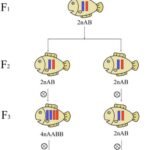
Rainbow trout is receiving a genetic upgrade thanks to a new technique utilizing thermal shock. Researchers in Brazil have successfully produced fully homozygous rainbow trout (clones) using a method known as thermally induced gynogenesis. This innovative approach holds immense potential for fish breeding and genetic improvement in aquaculture.
Scientists from Embrapa Recursos Genéticos e Biotecnologia (DF), the Instituto de Pesca da Agência Paulista de Tecnologia dos Agronegócios (IP-APTA) of the Secretaria de Agricultura e Abastecimento (SAA) of São Paulo, completed two decades of research work resulting in the proof of generation of a clonal lineage of rainbow trout (Oncorhynchus mykiss) using the induced gynogenesis technique. They evaluated the efficiency of standard thermal shock protocols in producing rainbow trout clones using females from a locally adapted strain in Brazil.
What is gynogenesis?
Gynogenesis is a form of asexual reproduction in which offspring develop from eggs fertilized by genetically inactivated sperm. Essentially, this creates offspring that are genetically identical to their mothers.
According to Alexandre Rodrigues Caetano, one of the researchers at Embrapa who collaborated in drafting the article, gynogenesis is a type of natural cloning that can be induced in the laboratory. “The method was developed in the 1960s and involves manipulating embryonic development through thermal or pressure shocks. In this process, the embryo develops without the genetic contribution of the male,” explains the researcher.
To achieve this induced cloning, male sperm is genetically inactivated through ultraviolet irradiation. After fertilization of the (haploid) female egg with this material, a thermal shock is applied to the embryo to prevent the first cell division, turning the embryo into a diploid. From then on, it will develop with exclusively maternal genetic material, thus generating a complete homozygous individual, which, subjected to subsequent gynogenetic reproduction, will produce a lineage of clones.
“This technique generates lines of rainbow trout clones that can be used in certain advanced studies of immunology, animal health, and nutrition, where it is interesting to have animals with identical genetic material,” explains Caetano. He highlights that it is also possible to develop two lines of clones with specific characteristics and cross them to generate fish that grow to harvest with higher productivity. In other words, identical offspring with selected traits.
The twist of thermal shock
The Brazilian study employed thermal shock to manipulate the process of cell division in gynogenetic embryos. By applying heat at specific stages, researchers were able to create two types of gynogenetic offspring:
- Meiotic gynogenesis (G-Me): This method blocks the extrusion of the second polar body, resulting in a diploid embryo (two sets of chromosomes) that is genetically identical to the mother.
- Mitotic gynogenesis (G-Mi): Here, thermal shock suppresses the first cell division, creating a tetraploid embryo (four sets of chromosomes). This tetraploid then undergoes chromosomal reduction to become a diploid with a completely homozygous genome (identical copies of each chromosome).
Results
The study compared survival rates of embryos subjected to different treatments:
Stay Always Informed
Join our communities to instantly receive the most important news, reports, and analysis from the aquaculture industry.
- Gynogenesis by thermal shock (G-Me and G-Mi) showed lower survival rates compared to normal diploid controls.
- However, the offspring of G-Me and G-Mi derived from females produced by meiotic gynogenesis (FG) had significantly higher survival rates than those derived from conventionally bred females (FC).
- The researchers successfully established a mitotic gynogenetic line that was 100% clonal, meaning all individuals were genetically identical.
Significance for rainbow trout fish farming
This research demonstrates the potential of thermal shock-induced gynogenesis to produce genetically uniform lines of rainbow trout. These clones offer several advantages:
- Enhanced disease resistance: Clones with desirable disease resistance traits can be propagated, resulting in healthier fish populations.
- Faster growth rates: Selective breeding of clones with superior growth performance can accelerate production cycles.
- Improved uniformity: Clones ensure consistent product quality in terms of size, flavor, and other desired characteristics.
“Last year, we analyzed various rainbow trout materials in the country using the TrutaPLUS tool, another tool offered by Embrapa’s AquaPLUS platform. Among them was the clonal lineage developed by IP-APTA-SAA, which was analyzed with SNP markers. With this, we were able to confirm that the lineage obtained through induced gynogenesis is truly a clonal lineage, an essential condition for publishing the scientific article,” notes Caetano.
Yara Aiko Tabata, a researcher at the Núcleo Regional de Pesquisa em Salmonicultura Dr. Ascânio de Faria, IP-APTA-SAA, highlighted that the center aims to promote trout farming through research and technological dissemination. “Part of the results of these researches are transferred to trout farmers in the form of products and processes, such as embryonated eggs and monosex fingerlings, triploids, trout roe caviar, among others,” explains Tabata.
Conclusion
Thermal shock-induced gynogenesis opens doors to significant advancements in rainbow trout aquaculture. Producers can optimize production efficiency and product quality by creating genetically uniform lines with desirable traits. This research paves the way for further exploration of gynogenetic techniques in other fish species, potentially revolutionizing the aquaculture industry.
AquaPLUS makes the producer’s life easier
The TrutaPLUS tool prevents inbreeding (among related animals), which can result in offspring with genetic problems, and also identifies the most suitable breeders, generating offspring with better performance. The pioneering study also generated information about the genetic structure of rainbow trout in Brazil. The technology was developed with resources from the Fundação de Apoio à Pesquisa do Distrito Federal (FAP-DF) and Embrapa itself.
The tool allows for obtaining simple, low-cost, practical, and innovative solutions capable of promoting qualification, management, and genetic improvement of species, as has been happening since the launch of the AquaPLUS platform, which brings together tools related to genetics for the analysis of populations and breeders of aquaculture species.
Through the services available on the platform, it is possible to determine if the breeding stock of aquaculture species has any degree of relatedness. It also reveals if they are pure or hybrid (resulting from crossbreeding with another species), thus allowing for guiding breeding both for the production of fattening fingerlings and for replacement, exchange, and trade of germplasm from breeding stock and, consequently, for reducing productivity losses.
TrutaPLUS is the fifth product available from AquaPLUS, which already provided services for tambaqui (Colossoma macropomum): TambaPLUS Parentesco and TambaPLUS Pureza; for vannamei shrimp (Litopenaeus vannamei): VannaPLUS, and for tilapia (Oreochromis niloticus): TilaPLUS.
Contact
Alexandre Rodrigues Caetano
Embrapa Recursos Geneticos e Biotecnologia Parque Estacao Biologica, Final Av. W/5 Norte Brasilia-DF, C.P. 02372, 70770-917 Brasil.
Email: alexandre.caetano@embrapa.br
Reference (open access)
Tabata, Y. A., Foresti, F., Hattori, R. S., Yoshinaga, T. T., Butzge, A. J., Araújo Júnior, N. T. D., Ianella, P., & Caetano, A. R. (2024). Generation and genetic analysis of a rainbow trout (Oncorhynchus mykiss) clonal line produced by gynogenesis. Aquaculture Reports, 36, 102032. https://doi.org/10.1016/j.aqrep.2024.102032
Editor at the digital magazine AquaHoy. He holds a degree in Aquaculture Biology from the National University of Santa (UNS) and a Master’s degree in Science and Innovation Management from the Polytechnic University of Valencia, with postgraduate diplomas in Business Innovation and Innovation Management. He possesses extensive experience in the aquaculture and fisheries sector, having led the Fisheries Innovation Unit of the National Program for Innovation in Fisheries and Aquaculture (PNIPA). He has served as a senior consultant in technology watch, an innovation project formulator and advisor, and a lecturer at UNS. He is a member of the Peruvian College of Biologists and was recognized by the World Aquaculture Society (WAS) in 2016 for his contribution to aquaculture.




